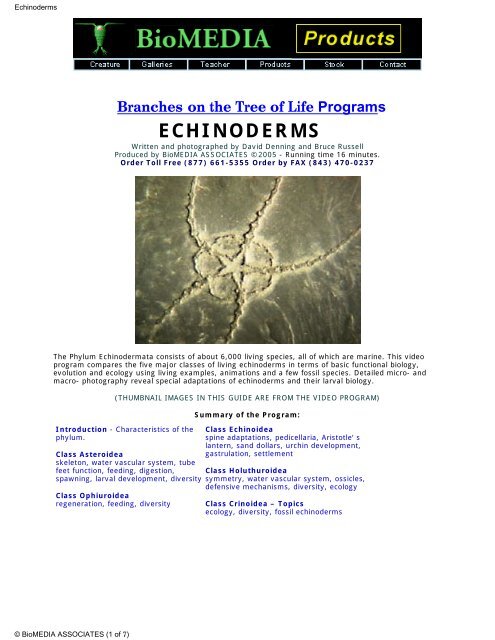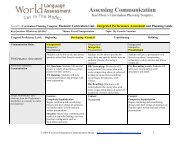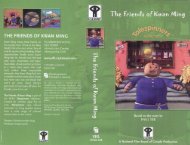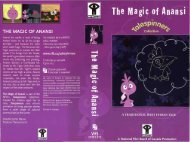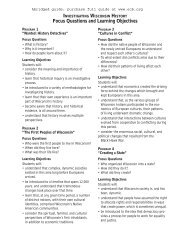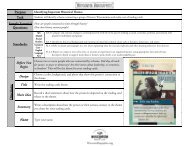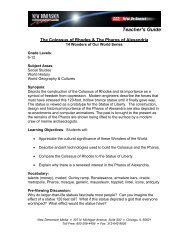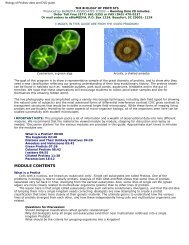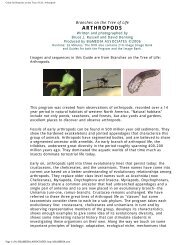Biology Of Echinoderms - BioMedia Associates
Biology Of Echinoderms - BioMedia Associates
Biology Of Echinoderms - BioMedia Associates
You also want an ePaper? Increase the reach of your titles
YUMPU automatically turns print PDFs into web optimized ePapers that Google loves.
<strong>Echinoderms</strong>Branches on the Tree of Life ProgramsECHINODERMSWritten and photographed by David Denning and Bruce RussellProduced by BioMEDIA ASSOCIATES ©2005 - Running time 16 minutes.Order Toll Free (877) 661-5355 Order by FAX (843) 470-0237The Phylum Echinodermata consists of about 6,000 living species, all of which are marine. This videoprogram compares the five major classes of living echinoderms in terms of basic functional biology,evolution and ecology using living examples, animations and a few fossil species. Detailed micro- andmacro- photography reveal special adaptations of echinoderms and their larval biology.(THUMBNAIL IMAGES IN THIS GUIDE ARE FROM THE VIDEO PROGRAM)Introduction - Characteristics of thephylum.Class Asteroideaskeleton, water vascular system, tubefeet function, feeding, digestion,spawning, larval development, diversityClass Ophiuroidearegeneration, feeding, diversitySummary of the Program:Class Echinoideaspine adaptations, pedicellaria, Aristotle‘slantern, sand dollars, urchin development,gastrulation, settlementClass Holuthuroideasymmetry, water vascular system, ossicles,defensive mechanisms, diversity, ecologyClass Crinoidea – Topicsecology, diversity, fossil echinoderms© BioMEDIA ASSOCIATES (1 of 7)
<strong>Echinoderms</strong>... ...The characteristics that distinguish Phylum Echinodermata are: radial symmetry, internal skeleton, andwater-vascular system. <strong>Echinoderms</strong> appear to be quite different than other ‘advanced’ animal phyla,having radial (spokes of a wheel) symmetry as adults, rather than bilateral (worm-like) symmetry as inother triploblastic (three cell-layer) animals. Viewers of this program will observe that echinoderm radialsymmetry is secondary; echinoderms begin as bilateral free-swimming larvae and become radial at thetime of metamorphosis. Also, in one echinoderm group, the sea cucumbers, partial bilateral symmetry isretained in the adult stages -- sea cucumbers are somewhat worm–like.<strong>Echinoderms</strong> have an internal skeleton made of bony plates (ossicles) of calcium carbonate. They depositthis material after extracting dissolved calcium and carbonate (bicarbonate) ions from sea water. Insome species, such as the sea urchin, plates of the skeleton are locked together to form a rigid structure.On the other hand, most sea stars and brittle stars can flex their ‘arms’, indicating that the skeleton hasgaps and flexible plate junctures. Sea cucumbers have no real skeleton; only tiny remnant ossicles.Many echinoderms have spines. In fact, the word ‘Echinodermata’ means ‘spiny skinned’. The spinesalso are part of the internal skeleton and are covered by epidermis. It is usually a great surprise tostudents to learn that spines, such as the 40-centimeter long needle-like tropical urchin spines ofDiadema, are actually internal structures.Another phylum-level characteristic of echinoderms is the water vascular system, detailed in the sectionon Class Astroidea. The water vascular system functions primarily in movement, but oxygen exchange,and molecular nutrient uptake are also known functions of this system....Class AsteroideaClass Asteroidea, the sea stars, contains about 1700 living species of echinoderms. The name ‘starfish’,commonly used in the past, is being replaced by the name, ‘sea stars’, recognizing the lack of any closeaffinity of this group to fishes.A dried sea star, with skin removed, shows a meshwork of bony plates and spines, creating the hardenedendoskeleton. Holes in the endoskeleton reveal where projections of the body wall can be extended outinto the sea water to function as oxygen and molecular exchange organs. These finger-like projections,the papillae, increase the surface area, improving gas exchange with the surrounding sea water.Sea star movement involves hundreds of tube feet, small hollow tubes each tipped with a suction disc,and powered by the water vascular system. The intake to the water vascular system, the madreporite, isa stony sieve plate on the sea star‘s aboral surface. It acts as a screen to keep out detritus andparasites. Animation shows that the water vascular system has a central ring canal and connecting tubesrunning out into each ray.Each tube foot is connected to the radial canal and also to a balloon-like ampula. The muscular ampulaworks like a squeeze bulb, forcing water into the tube foot, causing it to straighten and extend. Biologistslong thought that a suction disc at the end of each tube foot provided all the animal’s holding power.However, recent investigations revealed that the tube foot can supplement its disc suction with achemical cement that significantly increases holding power. Some sea stars, such as the Pacific CoastPisaster ochraceus live in intertidal rocky habitats that experience phenomenal forces; equivalent to awind blowing across the land at 1000 km/hour. Amazingly, the holding cement applied by the tube footis ‘reversible’, through a biochemical process deployed by the sea star as it moves across the rock.Although asteroids (and other echinoderms) have a relatively simple nervous system, lacking a ‘brain’,© BioMEDIA ASSOCIATES (2 of 7)
<strong>Echinoderms</strong>they have the ability to coordinate hundreds or even thousands of tube feet for directional movement.The Pacific Coast sunflower star, Pycnopodia, can have more than 40,000 tube feet. Sea stars havesimple eye spots at the end of each arm, probably used for orientation to light. They use chemicalreception to orient to food resources.The ecology of the Pacific Coast common ochre star has been studied in detail. Having a water vascularsystem, it is relatively intolerant of exposure by low tides of the daily tidal cycles. Therefore, it generallylives lower down in the intertidal region, and moves upward during periods of high tide to feed on itspreferred prey species, mussels and barnacles. (For a detailed visual treatment of this and other shoreecology topics, see our program, The <strong>Biology</strong> of Seashores.)...Sea stars feed by forcing their stomachs out of their bodies (eversion) onto, or into, the prey. Then theysecrete powerful digestive enzymes to break down the prey in it’s own body. Animation reveals thatpartially-digested nutrients are sucked back into the stomach region or they are brought in to the bodythrough active transport. Once inside, nutrients are transported by ciliary action into digestive glands ineach ray. The food molecules pass into the body fluid for distribution to the skin and other parts of thesea star’s body. In most sea stars, undigested material is pushed out the oral opening, while somematerial is eliminated through a small anus located on the top (aboral) surface.Also on top are five gonopores, openings where eggs or sperm are shed directly into the sea.<strong>Echinoderms</strong> are usually dioecious, male and female reproductive systems in separate individuals. Larvaldevelopment goes through several stages on the way to becoming a baby sea star. After gastrulation,the larval series (including a bipinnaria larva) has bilateral symmetry, until metamorphosis, when theanimal assumes the radial symmetry of the adult. Details of larval development are treated below in thesection on Class Echinoidea....Class OphiuroideaClass Ophiuroidea contains the brittle stars (also called serpent stars) and the basket stars. Ophiuroidmeans ‘snake-like’, referring to the form and motion of the arms. The arms of brittle stars are easilybroken off, but will regenerate in a few days to weeks. Sea stars can also regenerate arms that arebroken off, but for most species, the central region of the body must remain intact. Only a very fewspecies, such as tropical species of Linkia, can actually regenerate an entire new body from a piece ofarm that has broken off.The tube feet of brittle stars are pointed, so this group does not use suction-mediated movement. Theanimal moves by using the arms in a kind of rowing stroke. The tube feet push materials aside, and alsochemically detect food and move it to the mouth on the undersurface (oral side) of the disc. Brittle starsand basket stars are detritus-feeders and opportunistic scavengers. They usually collect small pieces ofdecaying matter that has fallen to the bottom or is drifting near the sea floor.Ophiuroids are the most abundant class of echinoderms, with over 2000 species living in almost everyocean floor habitat. They have been dredged up from the deepest areas of the ocean.Class EchinoideaClass Echinoidea includes the sea urchins, heart urchins and sand dollars. The basic body-plan of thisgroup involves a rigid endoskeleton, with a covering of outward-pointing spines. Sea urchins aregenerally more spherical, and the spines can vary from the extraordinary long and thin spines of tropicalDiadema, to the stout spines of pencil urchins used for wedging into coral pockets, to intertidal specieswith flattened spines (for deflecting waves) to other species with short thin spines. One species of© BioMEDIA ASSOCIATES (3 of 7)
<strong>Echinoderms</strong>tropical urchin, Toxopneusta, has only a few spines but its surface is covered with another defensivestructure -- highly poisonous pedicellaria. (Poisoning from these pedicellaria has resulted in death for afew people who have handled or encountered these tropical urchins).Urchin pedicellaria are three-jawed pincer claws (whereas those of Asteroids have two jaws). Pedicellariaseem to have two main functions - to discourage small larva from settling on the surface of anechinoderm, and for defense against predators. In response to an attack from a soft-bodied predator,(such as the Pacific sunflower star Pycnapodia), red, green, or purple sea urchins will move their spinesaside, and deploy their multiple pedicellaria to pinch the predator. Usually, this will deter thesoft-skinned predator.... ...On the other hand, a hard-skinned predator, such as a large cancer crab, is relatively unaffected bypedicellaria. In cases of attack from these predators, the urchin will direct its spines (which can be aimedoutward in any direction), toward the predator.Urchins are primarily herbivores or detritus feeders, although some actively feed on attached animalssuch as sponges or sea squirts. A sea urchin’s mouth is located on its underside. Inside the mouth is aunique jaw structure called the ‘Aristotle’s Lantern’, here revealed through dissection. The structure issuspended inside the spherical endoskeleton (test) by a rigid frame that also provides attachment formuscles to control the biting and ripping functions of the jaws.Looking at the urchinÕs test, one can see the rows of holes where the tube feet extend outward from theinternal water vascular system, through the endoskeleton and out into the environment. In many urchinspecies, the tube feet can be extended outward to distances greater than the length of the spines. Thisallows the urchin to hold onto food that drifts against the spines, and move it to the mouth.Sand dollar, heart urchins, and sea biscuits are echinoids where the endoskeleton is modified withvarious degrees of flattening. These represent adaptations for burrowing into different substrates - thehighly flattened sand dollar lives in coarse sand, while the more bulbous heart urchin burrows in softmuds. In these cases, the animals have also retained a portion of the bilateral symmetry, and there is aforward end which leads the burrowing. These burrowing echinoids are detritus-feeders.... ...Sea urchin development is a well-studied process, and an excellent one for classroom observation.Gametes are produced by carefully injecting the fertile animals with potassium ion solutions. The eggsand sperm are collected in sea water, and the entire process of fertilization and development throughlarval stages can be observed through the microscope at intervals over several weeks. In this program,we show fertilization, blastula, gastrula, and several stages of larval development, using both normalmicroscope lighting and ‘cross-polarized’ microscope lighting to show the remarkable development oflarval spines and their transformation at the time of metamorphosis. (We demonstrate some of thesesimply-deployed microscope techniques in our program The Light Microscope: Window on theMicrocosm).Class HolothuroideaClass Holothuroidea is another group of common echinoderms, with over 900 species worldwide. Likebrittle stars, these animals are detritivores, performing the important ecological function of ‘mopping-up’the dead and decaying material that falls to the ocean floor.The common name, sea cucumber, is particularly appropriate. Although few holuthuroids are green,many bear a strong resemblance to our garden cucumbers. The worm-like body suggests that they are© BioMEDIA ASSOCIATES (4 of 7)
<strong>Echinoderms</strong>bilateral creatures, not radially symmetrical; but their relationship to other echinoderms is shown clearlyby an animation that transforms the horizontal sea cucumber body into the vertically-oriented body ofthe sea urchin.All sea cucumbers have tube feet and a water vascular system (although highly modified). In manyspecies, the three double-rows tube feet on the upper surface have been ‘lost’ through evolutionaryadaptation. Sea cucumbers have also ‘lost’ the bulky endoskeleton prominent in other echinodermgroups. The skin is leathery, and remnants of the endoskeleton in the form of microscopic bony platesare embedded inside the skin tissue.... .. .Sea cucumber defenses include powerful toxins secreted by the skin and toxic, and sticky tubes thatshoot out the anus of some tropical species (tubules of Cuvier).Class CrinoideaCrinoids, commonly called feather stars, are mostly found in warm tropical seas where they attach tocorals and other surfaces. Unlike other echinoderm groups, the crinoid’s mouth and anus are both on thetop side of the animal, facing up, and they are surrounded by five sets of branching, tentacle-bearingarms that trap suspended detritus and plankton. When sufficiently disturbed, crinoids may swim by anawkward movement involving an alternating flapping of the arms.<strong>Echinoderms</strong> evolved during the earliest proliferation of animal life, well over 510 million years ago.Fossil sea cucumbers have been found in the Burgess Shales, and fossil crinoids are common insediments dated to Devonian times and older. The class Crinoidea obviously survived until present times,but other classes did not. Paleontologists recognize at least 17 extinct classes of echinoderms....© BioMEDIA ASSOCIATES (5 of 7)
Review Questions - <strong>Echinoderms</strong>1. What does the name “echinoderm” mean? Discuss how this name applies to the differentclasses of echinoderms.2. Describe the function of an echinoderm tube foot.3. When you find sea stars along a rocky coast at low tide, they are often clustered in crevicesand under rock ledges. Why?4. Explain two ways in which echinoderms are NOT radially symmetrical.5. Do echinoderms see other organisms? If not, how do they find their food and avoidpredators?6. How do sea stars feed? How does this differ from sea urchins or sea cucumbers?7. Which group(s) of echinoderms is (are) most likely to feed on plankton and suspendeddetritus?8. Why do most echinoderms produce extremely large numbers of gametes?9. What are the major differences between a sea star (or sea urchin) baby (larva) and the adultanimal?10. In addition to spines, what do sea urchins have for defense, and how are these used?11. Describe differences between sea stars and brittle stars for: tube feet, body form,movement, feeding.12. Sea cucumbers look like worms. How is their form related to radial symmetry and to theother echinoderm groups?13. What happened to the endoskeleton in the sea cucumber line of evolution?14. Describe two ways in which crinoids differ from sea stars.16. Fossil evidence indicates that modern echinoderms probably evolved from an ancestorthat lived over 500 million years ago. What characteristics would this ancestor have had?15. Most major groups (phyla) of animals evolved in the ocean over 500 million years ago.Over time, many groups (phyla such as arthropods and molluscs) evolved to include speciesliving in freshwater and on the land, but echinoderms are only found in the sea. Why areechinoderms still restricted to the sea?17. Biologists believe that descendants of the first ancestral echinoderms include body plansquite different from modern living echinoderms. What is the evidence for this view?
Branches on the Tree of Life DVD - ECHINODERMSObservations SectionInquiry Approach: We recommend using the video observations ahead of the narrated program togenerate interest and encourage speculation. Some discussion questions are listed below, althoughit may be sufficient to simply ask—What is it? or, What is going on? … and then let the discussionflow from there. Information related to the Observation sequences is provided in either the narratedprogram or the Image Bank, which contains over 120 echinoderm still images with descriptions. Theimage bank is on the DVD, but not the VHS version of <strong>Echinoderms</strong>.Review: Using the observations for review, students can be encouraged to provide the narration.Observation #1 Urchin DevelopmentWith the volume of sperm liberated into the water by male urchins, eggs must have some meansof preventing fertilization by more than one sperm. How do they do it?A day after fertilization a hollow ball of cells (blastula) has formed. The first sign of furtherdevelopment is a tube that has formed through the hollow ball of cells. How might that tubehave formed? What might it become?Three days later the larva has developed needle-like structures that shine out in polarized light.New folds of tissue can be seen out-pocketing from the gut. What might they become? Does thisstage show radial symmetry like an adult echinoderm, or does it exhibit bilateral symmetry? Isthere any indication of what these planktonic larvae are feeding on?As the urchin develops over the next few days, more and more adult features can be seen. Morecrystalline structures show up brightly in polarized light. At what point does the larva appearto develop full radial symmetry? The last shot is of the juvenile urchin ready to settle and beginfeeding on whatever it can scrape from the rocks. It has two different kinds of spines, long andpointed and, short and forked at the end. Which kind are on the mouth side?Observation #2 PedicellariaUrchins and some seastars have little pincers called pedicellaria that have a defensive function.The demonstration shows how pedicellaria react to a bit tissue taken from a predatory sunflowerstar. Does it appear that the response requires touch, or are the pedicellaria able to respondto just the smell of sea star? Observing the response, do you think the pedicellaria respondindependently, or is some form of coordination?Observation #3 Urchin DissectionA dissection shows some of the urchin’s internal anatomy, but what are these structures? As inmost animals, some are reproductive, others digestive, and some associated with feeding.Observation #4 Juvenile Sea StarWhat is it? What might be the function of the red spots?Observation #5 Sea Cucumber and Sea Cucumber Dissection.What is it? What might be the function of the branched tentacles? How are the branchedtentacles controlled?


